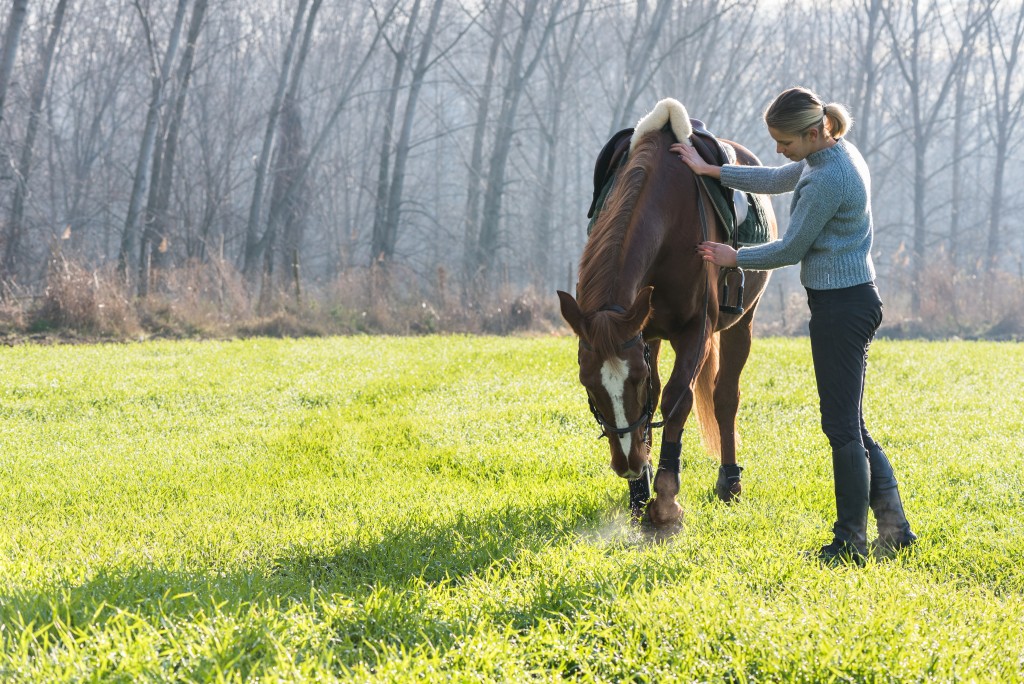Horse Health
How to Check Your Horse’s Temperature, Pulse, and Respiration
Learn how to measure your horse’s vital signs
Every horse owner needs to know how to check their horse’s temperature, pulse, and respiration (TPR) rate. These vital signs are indicators of your horse’s health and well-being.
A horse gallops with his lungs, preserves with his heart, and wins with his character.
–Federico Tesio (1869-1954)
When you have a baseline for your horse’s temperature, pulse, and respiration rate you can more easily and quickly catch health problems. An elevated heart rate or low temperature can be indicators your horse is stressed or unwell.
Along with hoof care, coat and skin health, and joint health care – monitoring temperature, pulse, and respiration rate allow you to give your horse the best attention and care possible.
Read on to learn why you need to check your horse’s temperature, pulse, and respiration rate and how to safely measure these horse vital signs.
As always, we recommend you contact your veterinarian and trainer before making any changes to your horse’s routine and diet. And it is super important to get a demonstration from a trained professional on how to measure your horse’s TPR.
Before taking your horse’s TPR, contact your veterinarian to find out how often should measure these values. You do not want to add stress to your horse by unnecessarily taking your horse’s temperature, pulse, and respiration rate.
Why You Need To Check Your Horse’s Temperature
Taking your horse’s temperature is one of the best ways to monitor their health and catch issues before they become larger health problems. A change in temperature can be an indicator your horse is getting sick or is injured.
Remember, horses are very good at hiding their injuries and other symptoms. Routinely taking your horse’s temperature ensures you’re on top of your horse’s health.
Knowing how your horse’s temperature fluctuates can help you understand the conditions best suited to your horse for different types of rides. Just like humans, not all horses enjoy hot humid conditions or cold damp days – your horse’s temperature can tell you a lot about which conditions help your horse thrive.
Additionally, an abnormal temperature can be signs of illness, injury, or stress. If your horse has an abnormal temperature, contact your veterinarian. It’s important you get to the source of the problem quickly.
Make sure you know these normal horse rectal temperature ranges:
- Adult horse: 99.5 to 101.5oF (37.5 to 38.6oC)
- Foals less than 1 month of age: 100.0 to 102.0oF (37.7 to 38.8oC)
Please remember this information on newborn foal temperatures from Extension Horses: Newborn foals can easily suffer from hypothermia (low body temperature), so if the foal’s temperature is below 98.0oF (36.6oC), call your veterinarian. In the meantime, rub the foal with towels or blankets to stimulate blood flow and/or dry its coat.
If your horse’s rectal temperature is above the normal range, this indicates a fever and if it’s below the normal range this can indicate hypothermia. Do not ignore these temperatures – contact your veterinarian.
How To Check Your Horse’s Temperature
To check your horse’s temperature, do the following:
- Tie your horse or have someone your horse knows hold your horse.
- Apply a small amount of lubricant to a digital horse thermometer.
- Stand beside your horse’s left hind leg. Do not stand behind your horse!
- Using your left hand, slightly lift your horse’s tail.
- With your right hand, insert the thermometer a couple of inches into your horse’s rectum.
- Do not let go of the thermometer. Wait for the temperature reading – depending on your digital thermometer, there will be a beep or other sound to indicate the temperature reading is finished.
- Read and record your horse’s temperature. Be sure to log your horse’s temperature so you can be aware of fluctuations and signs of illness, injury, and stress.
If you’re not confident about checking your horse’s temperature, ask your trainer or veterinarian to help you. Do not skip this important health check.
Why You Need To Check Your Horse’s Pulse
Checking your horse’s pulse and resting heart rate are key to monitoring your horse’s health. An elevated or low pulse rate are indicators your horse is struggling.
It’s also important to remember that exercise, age, overall physical health, the weather, stress, illness, injury, and external stimuli can impact your horse’s pulse and heart rate.
Make sure you know these horse pulse rate values:
- Adult horse: 32 to 36 beats per minute
- Newborn foals: 80 to 100 beats per minute
- Foals: 60 to 80 beats per minute
In general, an elevated heart rate is caused by colic or intestinal pain. The degree of elevation is a strong indicator of your horse’s pain level.
If your horse has a weak or soft pulse rate, this can indicate problems with the heart and can be sign of heart disease.
How to Check Your Horse’s Pulse with a Stethoscope
To check your horse’s pulse with a stethoscope, do the following:
- With the stethoscope in your ears, stand on the left or mounting side of your horse next to the shoulder facing your horse’s tail.
- Place the flat part of the stethoscope below your horse’s elbow on the chest wall.
- Lightly press the stethoscope and listen for the beat-beat sound and count this for 30 seconds. Double this number to get the number of beats per minute for your horse.
- Record and track your horse’s pulse rate and make sure you contact your veterinarian when the pulse rate is above or below normal.
This is not an easy measurement to take. Be patient and understand that your horse will likely not stand still for very long. This should not be a stressful experience for you or your horse.
Why You Need to Check Your Horse’s Respiration
Your horse’s respiration rate is a vital sign that can alert you when your horse is ill, stressed, or injured. Your horse’s respiration rate is the number of breaths your horse takes every minute.
By knowing your horse’s normal respiratory rate, you’re better able to catch problems before they become chronic or fatal.
Make sure you know these average horse respiration rates:
- Adult horse: 8 to 12 breaths per minute
- Newborn foal: 60 to 80 breaths per minute
- Older foal: 20 to 40 breaths per minute
Three Ways to Check Your Horse’s Respiration
Use one or all of these three ways to check your horse respiration rate:
- Watch your horse’s rib cage or flank and count the number of times the rib cage rises and falls for 15 seconds. Multiply this value by four to calculate the breaths per minute.
- Using your stethoscope, place the flat part on at the base of your horse’s neck. The closer you are to the trachea, the easier it is to hear your horse’s respiration rate.
- Put your hand under your horse’s nostrils and count the breaths as you feel them on your hand. This is the most challenging way of checking your horse’s respiration rate.
Along with counting the breaths and respiration rate, pay attention to your horse’s breathing sounds. Is your horse’s breathing ragged or shallow? Is there a crackly sound as your horse breaths?
Do not hesitate to contact your veterinarian with questions and concerns about your horse’s respiration rate. It’s always better to be overly cautious than to miss a sign or symptom.
Taking Care of Your Horse’s Health
Knowing your horse’s normal vital signs and regularly monitoring these health indicators helps both you and your horse. Know you’re doing all you can to keep your horse in the best health possible and alert to any changes.
Thank you for taking such great care of your horse. Contact us with any questions about your horse’s joint health, hoof care, digestion and immune health, and skin and coat health. We want your horse to live their best life and for you to know what we know about horse health and wellness.



